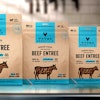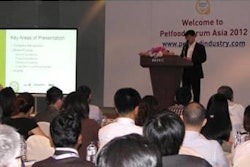Household Purchase Patterns
Pet Food and Supplies - US - August 2008
Dog food
Nearly half of all households (44.8%) made at least one purchase in the dog food category in 2007, with the bulk of those purchases being dry dog food. Households buy approximately 134lbs of dog food annually, 12lbs per shopping trip, on average. The purchase cycle for dog food is 45 days long, with consumers buying this item more than 11 times per year. When it comes to dog food, there are nearly as many varieties of brands as there are varieties of dogs because manufacturers offer formulations intended to meet specific needs.
Dry dog food
More than a third of these households purchased dry dog food at least once in 2007. The purchase cycle is 67 days-longer than that of the category and consumers buy dry dog food less often-5.4 times a year vs. 11.4. On average, consumers buy 130.8lbs of dry dog food annually, which is consistent with the category as a whole. Not surprisingly given its shelf-life, consumers buy twice as much dry dog food per shopping occasion as they do wet (more than 24lbs vs. 12lbs for the category). Private label leads in household penetration for this subcategory, probably due to price. However, Purina has several entries in the category and has greater overall household penetration in the dry dog food category than any other vendor. Nestlé Purina Petcare Co. ranks highest in household penetration (18.6%) with a variety of brands-Purina ONE (3.7%), Purina Dog Chow (3.7%), Purina Dog Chow Naturally Complete (1.8%).
Wet dog food
Wet dog food is less popular with these panelists; household penetration is less than 20%. Not surprisingly, wet dog food has a shorter purchase cycle (45 days compared to 67 days for dry dog food) given that it is sold in smaller quantities. Further, wet dog food seems to be a supplemental purchase or geared to smaller dogs-consumers buy just more than 47lbs annually (compared to 130.8lbs for dry dog food) and only 5.5lbs per purchase occasion. Many of the same brands are active in both wet and dry dog food. As in dry dog food, private label leads in household penetration but overall, Nestlé Purina Petcare Co. and Masterfoods USA have greater household penetration (approximately 12% and 11%, respectively).
Cat food
Household penetration for cat food is lower than that of dog food (39.1% vs. 44.8%). The purchase cycle for cat food is 42 days and consumers buy cat food about 13 times a year on average. Consumers buy 86.7lbs of cat food annually, 6.7lbs of cat food per purchase occasion. These lower volume figures are to be expected given that cats are smaller than dogs on average. As with dog food, cat food comes in a wide variety of offerings to meet different needs.
Dry cat food
Just more than a third (34.6%) of households purchased dry cat food at least once in 2007. The purchase cycle for this subcategory is 57 days, with 7.2 purchase occasions per buyer per year. Overall, consumers buy 66.5lbs of dry cat food, approximately 9.2lbs per purchase occasion. Private label leads in household penetration for dry cat food, as well. As with dry dog food, Nestlé Purina Petcare Co. has a variety of brands in the category and leads in overall household penetration when the brands are considered together (23.7%).
Wet cat food
Almost a quarter of these households (23.6%) purchased wet
cat food in 2007. The purchase cycle is 41 days, with 11.8
purchase occasions per buyer. Consumers buy 44.3lbs of wet cat
food per buyer per year, and 3.8lbs per purchase occasion.
While private label is certainly a player in wet cat food, this
is the only subcategory in this report where it does not lead
in terms of household penetration. Friskies and its various
brand extensions dominate the category.
© Mintel International Group Limited.
















